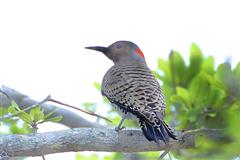Flicker - Northern
Common Flicker, Yellow Shafted Flicker Scientific Name: Colaptes auratus
Tue, 29th April, 2025 - 12:16 am GMT
Sponsor Ads:

Alternative Name
Common Flicker, Yellow Shafted Flicker Scientific Name: Colaptes auratusBasic Info
The Yellow Flicker is a very distinct bird, its coloring scheme a unique one. Named for the yellow feathers shown beneath the tail and wings while in flight, this woodpecker has a gray head, with a red nape and black collar. It has a long, slightly curved, elegant bill, designed specifically for making nests in the tough bark of conifer and deciduous trees.
Health
If you want to attract Northern Flickers to your backyard, try doing some of the following things. First, keep a fresh, clean birdbath around at all times, making sure the water is sparkling clear. Don't kill the ants in your garden or backyard; using pesticides on these ants will effectively cut off the Flicker's main food source, and deter it from entering your yard at all. They also enjoy eating apples, raisins, and peanut butter, and leaving these things out for them will certainly get them a bit closer to your viewing area. Breeding The Northern Flicker's breeding season starts in March and ends in May. Mating pairs are mates for life. The female will lay a clutch of five to eight eggs, and they will incubate them for around 12 days. Both the male and the female will incubate the eggs. These birds typically only raise one brood every mating season, and they after they hatch, they'll start to fledge after about three weeks. They will rely on the parents for food and protection for another three weeks.Habitat
N/ABehavior
The Northern Flicker, also known as the "Common Flicker" or "Yellow Shafted Flicker" used to be more common; for the last few years, they have declined heavily in numbers, albeit not enough to make it onto any endangered species list; still, you will see them far less often than the common Robin or Grackle. The Yellow Flicker is attracted mostly to coniferous or deciduous trees, nesting in places where there is a lot of open space and a lot of food. Ants are the food of choice for Yellow Flickers, and their presence will attract Yellow Flickers almost assuredly. If you choose to use pesticides to remove ants from your garden, you may be reducing your chances of being visited by a Northern Flicker! They will also feed happily from feeding trays left out, enjoying the taste of peanut butter and raisins, as well as the occasional apple. Flickers also eat suet in the winter when it's hard for them to find ants. If you keep your backyard the same year after year, and the Yellow Flicker has nested there, you may be in luck; these woodpeckers have a tendency to return to the same nesting site year after year, so they can be found in the same area after migrating and mating seasons are over. The Yellow Flicker nests mostly across the United States, particularly in the north, as well as the Gulf of Mexico and parts of Newfoundland. The birds that stay in the northern parts of the United States will eventually migrate south when it gets too cold. They are fiercely loyal to their mates, and their call is a piercing one, one that they will use repeatedly to find their beloved mates. Interestingly enough, the Yellow Flicker is the only woodpecker known to feed on the ground.t is known to hop along the ground, looking for ants where it can find them, sticking its bill into the anthill and digging the ants out with its tongue. Using pesticides in your garden will not usually harm the Yellow Flicker, but be warned; killing the ants in your garden will ruin your chances of attracting this bird.Origin
North AmericaHistory
Known for its love of ant eating the Northern Flicker woodpecker is a welcome visitor to many North American homes!Common Foods
It forages for ants, subsisting mostly on these tiny insects to feed its brood. ISponsor Ads:
If you want to create new markets, or disrupt old ones, you create ubiquitous infrastructure. -- Doc Searls
Flicker - Northern
Coded by: BGID® | ALL RIGHTS RESERVED Copyright © 2000-2025
Disclaimer | Privacy | Report Errors / Contact | Credits










